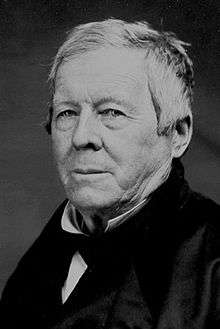Thomas Garrett

Thomas Garrett (August 21, 1789 – January 25, 1871) was an American abolitionist and leader in the Underground Railroad movement before the American Civil War.[1]
Early life and education
Garrett was born into a prosperous landowning Quaker family on their homestead called "Thornfield" in Delaware County, Pennsylvania. The house in which he lived until 1822, built around 1800, still stands today in what is now Drexel Hill in Upper Darby Township.
In a family already inclined to abolitionism, Thomas was exceptionally dedicated. When a family servant was kidnapped by men who planned to sell her as a slave in the South, he tracked them down and released her.
Career

In the schism between Orthodox and Hicksite Quakers, Garrett split with his Orthodox family and moved to Wilmington in the neighboring slave state of Delaware to strike out on his own and pursue his struggle against slavery. He established an iron and hardware business and made it prosper.
In 1827 Society of the State of Delaware was reorganized as the Delaware Abolition Society, whose officers and directors included Garrett, William Chandler, president John Wales, vice-president Edward Worrell, and others. Later that year, Wales and Garrett represented the group at the National Convention of Abolitionists.[2]
In 1835, Garrett became a director of the new Wilmington Gas Company, which made gas "made from rosin, at $7 per 1,000 cubic feet" for lighting lamps.[3] In 1836, he invested with Chandler, Joseph Whitaker, and other partners to revive the Principio Furnace in Perryville, Maryland.[4]
Garrett openly worked as a stationmaster on the last stop of the Underground Railroad in the state. Because he openly defied slave hunters as well as the slave system, Garrett had no need of secret rooms in his house at 227 Shipley Street. The authorities were aware of his activities, but he was never arrested. In 1848, however, he and fellow Quaker John Hunn were sued in federal court. They were tried in the New Castle Court House, where James A. Bayard, Jr. served as prosecutor and U.S. Supreme Court Chief Justice Roger B. Taney presided. Garrett and Hunn were found guilty of violating the Fugitive Slave Act by helping a family of slaves escape.[5] Garrett, the "architect" of the escape, was fined $4,500. A compromised settlement was made and a lien was put on his house until the fine was paid. With the aid of friends, Garrett paid the fine and continued in his iron and hardware business and helping runaway slaves to freedom.
Garrett was visited by William Lloyd Garrison, whom he admired greatly. However, they had different views regarding the opposition to slavery. Garrison was a complete non-resistant. He was willing to be a martyr to the abolition of slavery and would not defend himself if attacked physically. Garrett, on the other hand, believed slavery could only be abolished through a civil war and, when he was attacked physically, defended himself by subduing his attackers.
Garrett was also a friend and benefactor to the great Underground Railroad Conductor Harriet Tubman. She passed through his station many times, during which he frequently provided her with money and shoes to continue her missions of conducting runaways from slavery to freedom. Of note, Garrett provided Tubman with the money and the means for her parents to escape from the South. (Both were free people at the time Tubman rescued them, but Tubman's father was to be arrested for secreting runaway slaves in his cabin.)

The number of runaways Garrett assisted has sometimes been exaggerated. He said he "only helped 2,700" before the Civil War put an end to slavery.
During the war, his house was guarded by the free Negroes of Wilmington. During the passage of the 15th Amendment, giving Negro males the right to vote, the Negroes of Wilmington carried him through the streets in an open barouche with a label, "Our Moses."
Garrett died on January 25, 1871, at the age of 81. His body, on a bier, was borne on the shoulders of freed blacks to the Quaker Meeting House on West 4th Street in Wilmington, where he was interred.
A municipal park in Wilmington is named Tubman-Garrett Riverfront Park after the two Underground Railroad agents and friends.
See also
References
- ↑ African American Registry http://aaregistry.org/historic_events/view/thomas-garrett-dedicated-abolitionist. Accessed May 10, 2015
- ↑ Scharf, John Thomas (1888). History of Delaware : 1609-1888. L.J. Richards. Retrieved November 27, 2013.
- ↑ "Items of Interest from Various Localities". The American Gas Light Journal. 75. July–December 1901.
- ↑ Historical Society of Cecil County, "Principio", Milt Diggins
- ↑ "National Historic Landmark Nomination" (PDF). National Park Service. Retrieved 6 January 2015.
- Station Master of the Underground Railroad, the Life and Letters of Thoma Garrett, by Jame A. Mcowan: (Jefferson, NC.: McFarland & Co., 2005).
- Claus Bernet (2010). "Thomas Garrett". In Bautz, Traugott. Biographisch-Bibliographisches Kirchenlexikon (BBKL) (in German). 31. Nordhausen: Bautz. cols. 484–486. ISBN 978-3-88309-544-8.
- Mariah Parker, Thomas Garrett, Quakers and Slavery, accessed April 17, 2011.
External links
| Wikiquote has quotations related to: Thomas Garrett |
- Biography at Spartacus Educational
- Pennsylvania Historical Marker
- Text of Wilmington's "Thomas Garrett Day" Proclamation
- History and Image of "Thornfield"
- Thomas Garrett at Find a Grave
